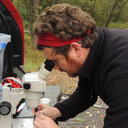Anaphylactic reaction to ingestion of Quercus ilex acorn nut.
Avainsanat
Abstrakti
BACKGROUND
A patient experienced an anaphylactic reaction after eating acorn nuts, fruit of the holm oak (Quercus ilex), one of the most abundant trees in Spain. Several urticaria episodes upon ingestion of peanuts were also referred.
OBJECTIVE
To assess the hypersensitivity reaction to acorn and to characterize the allergenic proteins involved.
METHODS
Cutaneous tests were performed using the skin-prick technique, using a large variety of grass, tree and weed pollens as well as fresh nuts and nut extracts. Specific IgE determination was assessed by RAST. IgE binding bands were determined by SDS-PAGE immunoblotting.
RESULTS
Skin-prick tests were strongly positive with acorn and peanut. Olea europaea, Quercus alba, Quercus ilex and grass pollens also elicited a weal higher than negative control. Patient serum had measurable levels of IgE antibodies especially to acorn, peanut and grass pollens. Only one protein band, of 17.9 kDa molecular mass, showed IgE-binding properties in the acorn extract. The possible homology of this strong allergenic protein with the group 1 tree pollen allergens was evidenced by the partial inhibition of the western blot with Bet v 1.
CONCLUSIONS
We present a case of anaphylaxis to acorn ingestion as demonstrated by in vivo and in vitro results. A 17.9 kDa IgE-binding band, showing some homology to group 1 pollen tree allergens, was recognized by patient serum.



